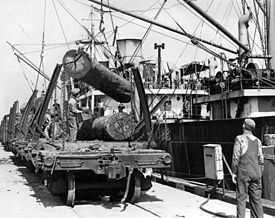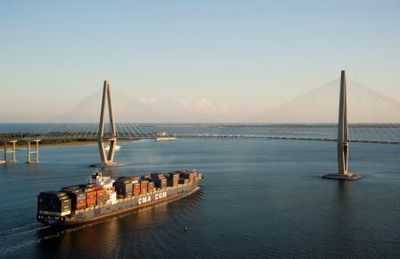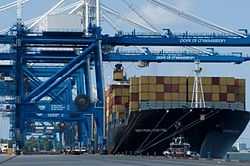Port of Charleston
| Port of Charleston | |
|---|---|
|
The 8,400-TEU container ship Northern Justice works at the Port of Charleston's Wando Welch Terminal | |
| Location | |
| Country | United States |
| Location | Charleston, South Carolina, USA |
| Coordinates | 32°47′05″N 79°55′26″W / 32.7846°N 79.924°WCoordinates: 32°47′05″N 79°55′26″W / 32.7846°N 79.924°W |
| Details | |
| Operated by | South Carolina Ports Authority |
| Owned by | South Carolina Ports Authority |
| Type of harbor | Container, breakbulk, cruise |
| Statistics | |
| Annual container volume | 1.51 million TEU in 2012 [1] |
| Value of cargo | $63 billion in 2012 [2] |
|
Website http://www.scspa.com | |
The Port of Charleston is a seaport located in South Carolina in the Southeastern United States. The port's facilities span three municipalities — Charleston, North Charleston, and Mount Pleasant — with five public terminals owned and operated by the South Carolina Ports Authority. These facilities handle containers; motor vehicles; and other rolling stock, non-containerized goods and project cargo, as well as Charleston's cruise ship operation. Additional facilities in the port are privately owned and operated, handling bulk commodities like petroleum, coal and steel.
Early History

Charleston's earliest history is tied to its prominence as a center of trade. After establishing Charles Towne along the banks of the Ashley River in 1670, the original settlers moved to the Charleston peninsula, favoring that location's natural harbor. By 1682 Charles Towne was declared the port of entry for the colony. From the founding of the colony until the start of the American Civil War, the colony's principal exports were lumber and naval stores, furs and animal skins, rice, indigo, cotton, and tobacco; and imports of primarily human traffic up until late 1700's. As a result of this trade, the colony flourished.
The Port of Charleston later suffered in the wake of the Civil War. The harbor itself was in shambles and filled with mines and the wrecks of sunken Confederate and Union ships. The Southern economy had little to export, and Charleston's network of private wharves were neglected and left to ruin. The establishment of several major federal military bases during the early 20th century benefited Charleston Harbor tremendously. Because of this federal presence, the harbor itself was well-maintained and greatly improved over the years. Mayor John P. Grace brought renewed interest in reviving the Port of Charleston's shipping presence by establishing the Port Utilities Commission in the early 1920s. In 1922 the city purchased the Charleston Terminal Company, which owned the majority of the peninsula's commercial waterfront assets, for $1.5 million. In 1942, the South Carolina Legislature established the South Carolina Ports Authority[3] with the responsibility to foster waterborne commerce for the benefit of the State of South Carolina.
Ranking, Volume and Investments

In 2012, the Port of Charleston ranked as the 8th port in the United States by cargo value, with $63 billion in imports and exports traded across the docks. In 2008, readers of Cargo Business News named the Port of Charleston the most productive port in their supply chain.[4] The Port of Charleston hosts shipping service by more than 30 of the world's top carriers, both on regular and inducement calls.
The South Carolina Ports Authority plans to invest $1.3 billion in new and existing facilities over a 10-year period.[5] This plan includes a new container terminal in North Charleston on the former Navy Base, as well as major improvements to existing facilities, technology upgrades and a new cruise terminal. Today the Port of Charleston boasts the deepest water in the southeast region and regularly handles ships too big to transit through the Panama Canal. A next-generation harbor deepening project is currently underway to take the Port of Charleston's entrance channel to 54 feet and harbor channel to 52 feet at mean low tide.
Terminals in the Port of Charleston
- Wando Welch Terminal – used for container cargo, located in the town of Mount Pleasant.
- Columbus Street Terminal – used for project cargo, breakbulk and roll-on/roll-off cargo. Located in the city of Charleston.
- Union Pier Terminal – used for cruise ship operations, located in Charleston.
- North Charleston Terminal – used for container cargo, located in the city of North Charleston.
- Veterans Terminal – used for project cargo, break-bulk and roll-on/roll-off cargo. Located in the City of North Charleston.
- Naval Base Terminal - 280 acre facility opening in 2018, to be used for container cargo. The facility, located in North Charleston, will increase port capacity by 50%.
Cruise Terminal and Union Pier Redevelopment
Cruise operations in the Port of Charleston are part of the South Carolina Ports Authority’s legislated mandate to increase maritime commerce. A study commissioned by the South Carolina Ports Authority projected that cruise operations could support 407 jobs and $37 million in economic benefits in 2010 in the Tri-County, though a follow-up study to determine actual costs and benefits has not occurred. In May 2010, the Carnival Fantasy began home-porting the Carnival Fantasy in the Port of Charleston.
To better handle ships, passengers, traffic and security requirements, the Ports Authority identified a need to improve and enhance the cruise terminal, which opened in 1973. Cruise ships have called Union Pier since 1913. The Ports Authority began hosting meetings, telling the community on how the agency envisioned to best develop an improved cruise facility. Through an extensive public process, including more than 100 meetings with neighbors and other stakeholder groups, the resulting Union Pier Concept Plan was endorsed unanimously by City Council in September 2010.
The new cruise terminal would be relocated north on Union Pier Terminal to an existing structure that would be renovated and modernized, freeing much of Union Pier for public uses and other non-industrial development if the Ports Authority chooses to sell it. If the port chooses to and is able to sell the remainder of the property, it could present an opportunity to re-knit about 35 acres of currently industrial property into the fabric of the city, while also re-connecting the city to the waterfront. The Ports Authority does not yet have permits for the new cruise terminal. A federal judge instructed the agency to re-apply for a federal permit, but the agency has not yet done so.
Shipyard
With the closure of the Naval Base and Charleston Naval Shipyard in 1996, Detyens, Inc. signed a long term lease. With three dry docks, one floating dock, and six piers, Detyens Shipyards, Inc. is the largest commercial facility on the East Coast. Projects include military, commercial, and cruise ships.
References
- ↑ Container Business Up 10% at South Carolina Ports in 2012 http://www.scspa.com/about/news/pressroom/pressroom.asp?PressRelease=370
- ↑ US Census Foreign Trade 920 Data Tables 1 and 4 http://www.scspa.com/About/statistics/dollarvalue.asp
- ↑ "Title 54 - Ports and Maritime Matters, Chapter 3. South Carolina State Ports Authority". South Carolina Code of Laws. South Carolina Legislature. Retrieved 29 December 2011.
- ↑ Charleston Regional Business Journal, Port of Charleston, Wando terminal lead poll
- ↑ SC Ports Capital Plan
